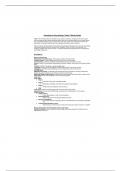Introductory Psychology: Exam 2 Study Guide
*Note: The information below is intended only as a guide to direct your studying for the second exam.
The terms listed for each section should be used to direct you to relevant sections of your notes and the
text. I recommend studying so that you know the what, when, where, why, and how for each term (as
applicable). Some exam questions will involve applying information (not just defining).
The exam will include 50 questions (100 points). Approximately 35 questions will come from new material
(Sleep and Dreaming, Basics of Sensation and Perception; Vision and Touch; and Learning). The
remaining questions will come from Exam 1 cumulative material (Psychological Science, Development,
and Biology of Behavior).
New Material
Sleep and Dreaming
altered state of consciousness: shift in quality or pattern of mental activity
circadian rhythm: a cycle of bodily rhythm that occurs over a 24 hour period
consciousness: a person’s awareness of everything that is going on around him or her
dreams: a state of consciousness characterized by sensory, cognitive, and emotional occurrences during
sleep
insomnia: inability to fall asleep or get good quality sleep
narcolepsy: a personal falls immediately into REM sleep during the day without warning
nightmares: bad dreams arousing feelings of horror, helplessness, extreme sorrow, etc.
non-REM sleep
REM behavior disorder: a mechanism that typically blocks the movement of voluntary muscles fails,
allowing the person to thrash around and get up and act out nightmares
REM sleep (Rapid Eye Movement); Increase in bodily functions and brain activity. 90% of dreams occur.
sleep apnea: person stops breathing for short periods during sleep
sleep need:
sleep stages:
● Stage 1
○ Light sleep, hypnic jerk, hypangogic images
● Stage 2
○ Temperature, breathing, amd heart rate decrease, sleep spindles
● Stage 3
○ Growth hormones releawsed, hard to wake up
● REM
sleep terrors: attacks of extreme fear that the victim has while sound asleep
sleepwalking: occurs during non-REM sleep; moving around or walking around in one’s sleep
theories of sleep
● Adaptive theory
○ Evolve sleep patterns in order to avoid predators
● Restorative theory
○ Sleep is necessary for the physical health of the body
● Memory Consolidation
○ the process by which a temporary memory is transformed into a more stable, long-lasting
form
● Creative thinking/problem solving
○ Mental process of searching for an original and previously unknown solution to a problem
Basics of Sensation and Perception; Vision and Touch
absolute threshold: minimum amount of simulus energy that must be present for the stimulus to be
detected 50% of the time
, afterimages: continuation of a visual sensation after removal of the stimulus
binocular cues: cue that relies on the use of both eyes
bottom-up processing: system in which perceptions are built from sensory input
color blindness (color-deficient vision): Defective cones in the retina of the eye and as a more general
term
cornea: Focuses light coming into the eye
depth perception: ability to perceive depth
Gestalt principles of perception:
● Proximity: Things that are close to one another tend to be grouped together
● Figure-Ground:The tendency to perceive objects or figures as existing on a background
● Similiarity: Things that are alike tend to be grouped together
● Continuity:
● Contiguity
● Closure
illusions: Misleading images presented to our vision
iris: Muscles that controls the size of the pupil
just noticeable difference: Difference in stimuli required to detech a difference between the stimuli
kinesthetic sense: Location of body parts in relation to one another; sense of the location of body parts
in relation to the ground and each other
lens: Changes shape to bring objects into focus
light becoming a neural impulse: mapped as an image along the surface of the retina by activating a
series of light-sensitive cells which are known as rod cells and cone cells
monocular cues (definition only, don’t need to know specific examples): cues that allow us to see
the depth through one eye. How one eye helps us see and process what we’re looking at
pain: unpleasant sensory and emotional experience associated with actual or potential tissue damage
perception: our recognition and interpretation of sensory information
perceptual constancy: Tendency to perceive familiar objects as having standard shape, size, color, or
location regardless of changes in the angle of perspective, distance, or lighting.
perceptual expectancy: Tendency to perceive things a certain way because previous experiences or
expectations influence those perceptions
pupil: small opening in the eye through which light passes
retina: light-sensitive lining of the eye
rods and cones:
● Rods
○ Processes noncolor vision
○ Darker conditions
● Cones
○ Processing color
○ Bright light, daylight conditions
sensation: process that occurs when special receptors in the sense organs are activated, allowing
outside stimuli to become neural signals in the brain
somesthetic senses: Convey information about touch, pressure, pain, and out-side temperature
theories of color
● Trichromatic Theory: Color vision is mediated by the activity of three types of cones-blue, green,
and red
● Opponent-Process Theory: Color is coded in opponent pairs: black-white, yellow-blue, and
red-green
top-down processing: interpretation of sensations is influenced by available knowledge, experiences,
and thoughts
vestibular senses: movement, body position; the sensations of movement, balance, and body position
visual accommodation: The process when the lens changes shape and allowing objects to come in and
out of focus
Learning
biological preparedness: Biological preparedness is the idea that people and animals are
inherently inclined to form associations between certain stimuli and responses.




